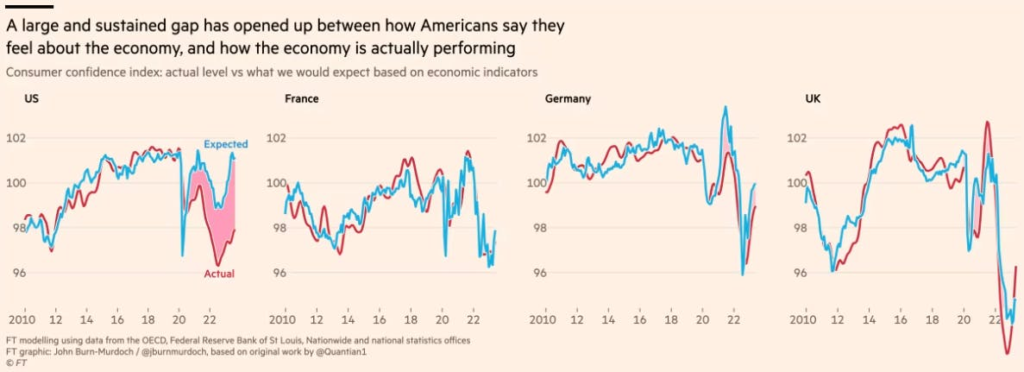How to live longer and better lives – from a longevity expert
Welcome to the forty-second edition of ‘3-2-1 by Story Rules‘.
A newsletter recommending good examples of storytelling across:
- 3 tweets
- 2 articles, and
- 1 long-form content piece
Let’s dive in.
🐦 3 Tweets of the week

Around 26% of The Netherlands is literally under sea level. How do they keep the water out, especially during high tide? This video gives you a good visual idea of their elaborate system of dams and dykes to keep their country above water.
Any implications for those worried about rising sea levels around coastal cities?

We are all privileged. I loved the line – ‘Where other people’s dreams end, your struggles begin’.

Hahaha, also Chennai folks and Mumbaikars.
📄 2 Articles of the week
a. ‘Should we believe Americans when they say the economy is bad?’ by John Burn Murdoch
In this data story, FT Journalist John Burn-Murdoch argues that there is a strong divergence between data and public sentiment in the US.
(In the chart below, the red line represents actual consumer sentiment, while the blue line is the prediction based on real econmic indicators. In short, sentiment is bad in Europe because of poor economic indicators, while sentiment is bad in the US, despite good economic indicators.)

Here’s how John concludes his post:
It seems US consumer sentiment is becoming the latest victim of expressive responding, where people give incorrect answers to questions to signal wider tribal political or social affiliations. My advice: if you want to know what Americans really think of economic conditions, look at their spending patterns. Unlike cautious Europeans, US consumers are back on the pre-pandemic trendline and buying more stuff than ever.
Incidentally, it’s interesting to see some of the Twitter reactions when someone posted this article. Granted, these are just a few people’s opinions, but the engagement they have on Twitter is quite high:


It’s always challenging when the data contradicts lived experience.
Jeff Bezos had said that: “…the thing I have noticed is that when the anecdotes and the data disagree, the anecdotes are usually right. There is something wrong with the way that you are measuring it.”
Maybe the data needs cross-checking. Maybe people need to update the stories in their heads.
Or maybe someone from the US government just needs to tell a better story!
b. ‘Money Stuff: Robots Make Good Junior Analysts’ by Matt Levine
In the article, Levine quotes a Bloomberg article for some examples of how ChatGPT is already transforming work in several professional service firms:
Consulting giants and law firms are looking to artificial intelligence to speed up the time it takes junior staffers to make it to the prestigious partner level as the technology eliminates vast swaths of the repetitive, time-consuming tasks that typically filled up their first few years on the job.
At KPMG, for instance, freshly-minted graduates are now doing tax work that was previously reserved for staff with at least three years of experience. Over at PwC, junior staffers are spending more time pitching clients rather than the hours they used to spend prepping meeting documents. And at Macfarlanes LLP, junior lawyers are interpreting complex contracts that their more experienced peers used to have to handle.
This is fascinating – if ChatGPT is doing all the grunt work, what exactly will the junior employees do? And from where would the firm get future partners?
But what does that mean for the staffing and training of professional services firms? Like if your model is:
1. ChatGPT can do the lower-level research work that would otherwise be done by junior employees, but
2. A senior partner with lots of experience, detailed domain knowledge, and human judgment needs to supervise ChatGPT and make the ultimate decisions,then where do the senior partners come from? Traditionally the way law firms, accounting firms, consulting firms, investment banks, etc., work is an apprenticeship model: You come in, you do research and grunt work and modeling, you learn the stuff, over time you build experience and knowledge and judgment, and eventually you become the senior person making decisions (and supervising the junior people). But that is an expensive model, and if you can hire ChatGPT to do all the grunt work and dispense with the junior people, you might just do it. But if you don’t have any junior people who are doing the grunt work and learning the business, how will you find new senior people to replace you?
His closing note – don’t worry, humans will figure out a way to replace the drudgery with something else (more drudgery? Or some client-facing time?):
I suppose that in, like, 1890, junior investment bankers spent all their time calculating Ebitda with quill pens and abaci, and when Excel was invented everyone was like “but how will our analysts receive the training they need to become partners if the spreadsheet just does it for them,” and in fact there was huge growth in investment banking jobs and profits and modern investment bankers know way more about finance, though less about abaci. Still, I am not sure that “well ChatGPT can do anything an analyst or associate would do, so let’s just put this 22-year-old in front of clients” is the right answer?
Excel just replaced one form of drudgery with another. Wonder what ChatGPT has in store…
🎧 1 long-form listen of the week
a. ‘Peter Attia – The Portfolio to Live Longer’ on Invest Like the Best with Patrick O’Shaughnessy
(Hat/tip: From Sajith Pai’s newsletter)
Dr. Peter Attia is a longevity expert, whose recent book ‘Outlive: The Science and Art of Longevity‘ offers science-backed ideas on how to live longer and better.
In this conversation, Patrick and Peter dive into quantifying the risk factors for a long life (e.g. how much worse is smoking vs. diabetes) and also quantify the impact of factors that push the needle in the good direction (exercise, diet, sleep, mental wellbeing).
Spoiler alert: Smoking is really bad, while exercise is the best tool on the positive side.
One interesting insight was the framing of medicine into 3 eras – Medicine 1.0, 2.0, and 3.0 and the concept of fast death and slow death.
1.0 is the pre-Industrial Revolution era (emphasis mine):
Before Medicine 2.0, obviously, there was something that I’m calling Medicine 1.0, and that was basically all of human history until the late 19th century. And we didn’t really have a sense of what was going on. We didn’t understand the natural laws of the universe. We didn’t have a scientific method or any of these things that we just take for granted today, and fast death was the norm.
So fast death was primarily that of infections, communicable diseases and trauma. That’s how people die. That’s how we died for millennia.
And then came the medical revolution of the 2.0 era – along with it’s shift from ‘fast death’ to ‘slow death’:
…you had the development of tools to treat these microbes in the form of antibiotics and ultimately, vaccines. And therefore, in a span of a really evolutionarily speaking, short period of time, we leapfrogged from Medicine 1.0 to Medicine 2.0, and we effectively get rid of fast death. In the span of a couple of generations, we double human lifespan by getting rid of infectious diseases.
…
And when I say getting rid of, I just mean reducing their mortality so much so that all of a sudden, an infection doesn’t mean the end of your life, trauma doesn’t mean the end of your life necessarily. And now we’re left with kind of a new problem. And the new problem is, “Oh, we do live longer now, but we’ve got a new set of deaths, and these are called slow deaths.” And these are the chronic diseases that virtually everybody listening to us talk today is thinking about.So nobody dies of those things quickly. Even a person who has a sudden heart attack and dies, this disease was taking place for 30 or 40 years prior.
The issue? We are treating slow death with the same tools we used to beat fast death:
So Medicine 2.0 was and remains an amazing tool or paradigm for how we deal with fast death. The problem is it has not been very successful at treating slow death. And its strategy has been the way you treat slow death is the way you treat fast death.
The way you treat fast death is you intervene when the disease is visible. We don’t go around treating people prophylactically for infections. I mean, I guess you could say we do that with vaccines. But we don’t go around treating people for car accidents before they have them. We wait until they have a car accident, then we treat them. And so when you try to apply that approach to diseases of slow death, it doesn’t seem to work that well. We ought to be doing more of the vaccine thing, which is a preventative thing. We’re not.
Instead, what we’re doing is we’re saying, look, once you have diabetes, we’re going to have to do X, Y and Z. Once you’ve had a heart attack or once you have significant risk factors for a heart attack that make it likely that you’re going to have a heart attack in the next 10 years, we really need to get serious about this. Once you have cancer, we’re going to do this operation, we’re going to use this amount of radiation, and we’re going to use this type of chemo. And those things have had some effect. I don’t want to suggest that they haven’t.
But the effect has been relatively small. So small in fact, that if you look at life expectancy in the late 19th century and compare it to today, while the nominal change has been a doubling, if you subtract out the causes of death from the top eight infectious and communicable diseases, it’s been almost flat. It’s a sobering statistic.
That is indeed a sobering stat.
Over the rest of the conversation, Dr. Attia shares some broad strategies on how not to depend on the government or the health system (both of which are still stuck in the Medicine 2.0 era) and instead take your health into your own hands.
And there’s some counter-intuitive advice on eating right – mainly that you don’t need to overthink it:
…there’s no doubt that we could be eating better food, but I also think most people tend to over-index that at the expense of exercise. If you look at the absolute battles that people have over social media with respect to this diet versus that diet and what about being vegan, what about being paleo, and it’s like, it might not actually matter as much as you guys think.
Are you in energy balance? Are you metabolically healthy? Are you getting enough protein? After that, I almost joke that I didn’t want to write the 2 chapters on nutrition because it creates so much substrate for people to argue about things. And what I really want to say is that those are the 3 questions that matter most. And the rest is just tactics and strategy around what to do.
That’s all from this week’s edition.
Photo by Rita Morais on Unsplash







